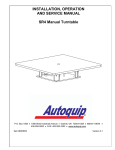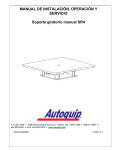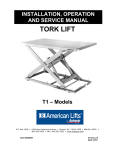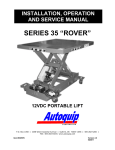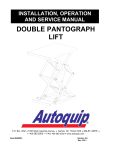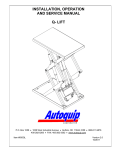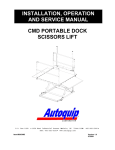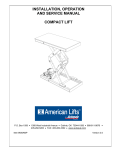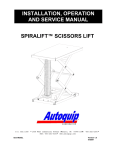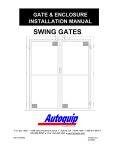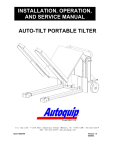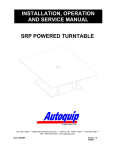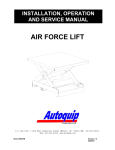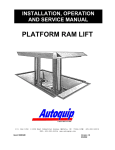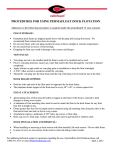Download SR4 Manual Turntable Installation, Operation and Service Manual
Transcript
INSTALLATION, OPERATION AND SERVICE MANUAL SR4 MANUAL TURNTABLE P.O. Box 1058 Item # 830SR4 • 1058 West Industrial Avenue Guthrie, • OK 73044-1058 • FAX: 405-282-8105 • www.autoquip.com 405-282-5200 • Version 1.0 01/30/01 TABLE OF CONTENTS Inspection 3 Dangers, Warnings, and Cautions 4 Label Identification 6 Specifications 8 Installation Instructions 9 Operating Instructions 17 Routine Maintenance 19 General Maintenance 20 Replacement Parts List 21 Troubleshooting Analysis 22 IMPORTANT Please read and understand this manual prior to installation or operation of this turntable. Failure to do so could lead to property damage and/or serious personal injury. If any questions arise, call a local representative or Autoquip Corporation at 1-888-8119876 or 405-282-5200. PLANNED MAINTENANCE PROGRAM A local Autoquip representative provides a Planned Maintenance Program (PMP) for this equipment using factory-trained personnel. Call a local representative or Autoquip Corporation at 1-888-811-9876 or 405-282-5200 for more information. 2 INSPECTION Immediately upon receipt of the turntable, a visual inspection should be made to determine that it has not been damaged in transit. Any damage found must be noted on the delivery receipt. In addition to this preliminary inspection, the turntable should be carefully inspected for concealed damage. Any concealed damage found that was not noted on the delivery receipt should be reported in writing to the delivering carrier within 48 hours. 3 DANGERS, WARNINGS & CAUTIONS Read and understand this manual and all labels prior to operating or servicing the turntable. All labels are provided in accordance with ANSI Z535.4. DANGER! Do not install the turntable in a pit unless it has a beveled-toe guard or other approved toe protection. A shear point can exist which can cause severe injury to the foot. DANGER! Extending the platform length or width beyond the factory limit could cause the turntable to tip, which could result in personal injury or death. WARNING! NEVER stand, sit or ride on the turntable! WARNING! All warning and information decals should be in place as outlined in the “Label Identification” section. If decals are missing or damaged, they should be replaced with new ones. Contact Autoquip for replacements. 4 DANGERS, WARNINGS & CAUTIONS WARNING! The turntable base MUST be lagged securely to the floor or sufficient structure, or attached to a lift platform (when applicable) before operating the turntable. WARNING! Load the platform top as evenly as possible to prevent overloading. 5 LABEL IDENTIFICATION Figure 1 Label Placement Diagram SR4 Turntable Label Information Item No. 1 2 Qty 2 2 Description Capacity No Riders 6 Part No. 36401586 36403706 LABEL IDENTIFICATION Note: Labels shown here are not actual size. Figure 2 Label 36401586 Figure 3 Label 36403706 7 SPECIFICATIONS LOAD CAPACITY 1. The load capacity rating is labeled on the top of the turntable platform. Turntables should not be overloaded beyond the established capacity as damage and/or personal injury may result. 2. When attaching the turntables to other pieces of equipment such as scissors lifts, remember that the rated capacity of the turntable must not exceed the rated capacity of the lift, tilter, etc. UNBALANCED LOADING 1. All standard turntable capacities assume that the load on the turntable is uniformly distributed and that the center of gravity of the load is placed within ten inches of the center pin. 2. Standard turntables are not designed to withstand true edge or axle loading. If edge or axle loading is anticipated, additional turntable platform support at the edges must be considered and provided. OPTIONS 1. Turntables are available with optional detents, locks, physical stops, limit switch signals, or beveled-toe guards. 2. The smallest turntable platform size with beveled-toe guards is 44” x 44” to adequately clear the support rollers mounted to the standard 24” x 24” turntable base plate. 3. Beveled-toe guards also add six inches to the lowered height of the standard manual turntable (ten inches total). 8 INSTALLATION INSTRUCTIONS FLOOR MOUNTING 1. Make sure the installation area is clean before starting. 2. Place the turntable base in the installation area. Set the turntable platform aside for now. CAUTION! When moving the turntable assembly, do not attempt to pick it up by the turntable platform; it is attached and could be damaged. Pick up the turntable from under the base frame at a joint ONLY. 3. The base plate of the turntable has pre-drilled holes for lagging the turntable securely to the floor. Mark the holes, drill, and install with anchors. Verify that the surface that the turntable will be mounted on is of sufficient strength to support the loads. 4. Install the turntable platform to the turntable base as shown in Figure 5. WARNING! The turntable base MUST be lagged securely to the floor or sufficient structure before operating the turntable. 9 INSTALLATION INSTRUCTIONS LIFT MOUNTING – Operating Above Floor Level 1. Make sure the lift surface is clean and level before starting. 2. Center the turntable base on the lift. Set the turntable platform aside for now. CAUTION! When moving the turntable assembly, do not attempt to pick it up by the turntable platform; it is attached and could be damaged. Pick up the turntable from under the base frame at a joint ONLY. 3. The base plate of the turntable has pre-drilled holes for attaching the turntable securely to the lift platform. Mark the holes, drill, and attach with Class 2 (or higher) hardware. The turntable base may be welded to the lift platform, if desired (See Figure 4). 4. Install the turntable platform to the turntable base as shown in Figure 5. WARNING! The turntable base MUST be attached securely to the lift platform before operating the turntable. 10 INSTALLATION INSTRUCTIONS LIFT MOUNTING – Operating Above and Below Floor Level 1. Make sure the lift surface is clean and level before starting. 2. Center the turntable base on the lift. Set the turntable platform aside for now. CAUTION! When moving the turntable assembly, do not attempt to pick it up by the turntable platform; it is attached and could be damaged. Pick up the turntable from under the base frame at a joint ONLY. 3. The base plate of the turntable has pre-drilled holes for attaching the turntable securely to the lift platform. Mark the holes, drill, and attach with Class 2 (or higher) hardware. The turntable base may be welded to the lift platform, if desired (See Figure 4). 4. Install the turntable platform to the turntable base as shown in Figure 5. WARNING! The turntable base MUST be attached securely to the lift platform before operating the turntable. 5. Turntables that have platform sizes larger than the lifts to which they are attached must have toe protection, such as beveled-toe guards. DANGER! Do not install the turntable in a pit unless it has a beveled-toe guard or other approved toe protection. A shear point can exist which can cause severe injury to the foot. 11 INSTALLATION INSTRUCTIONS 6. Check the pit dimensions. Overall length and width should be a minimal two inches longer and wider than the turntable platform. 7. To ensure that the turntable is positioned exactly over the opening in the floor before it is lowered, a position switch is mounted and wired to the turntable base (see Figure 6). 8. Lower the lift into the pit and check for proper combined height. 9. Position and adjust the platform in the pit making sure there is proper clearance (1” minimum around the edges from the platform to the pit angle). 10. Make the permanent electrical connections and operate the lift through a few cycles, ensuring that the lift will not lower if the turntable platform is not in the proper position. CLEAN UP 1. Clean up any debris from the area. A clean installation makes a good impression and creates a much safer environment! 2. Touch-up paint may be purchased from Autoquip for repair of damaged paint surfaces. WARNING! All warning and information decals should be in place as outlined in the “Label Identification” section. If decals are missing or damaged, they should be replaced with new ones. Contact Autoquip for replacements. 12 INSTALLATION INSTRUCTIONS Figure 4 Installation of Turntable Base to Floor or Lift Platform 13 INSTALLATION INSTRUCTIONS Figure 5 Installation of Turntable Platform to Turntable Base 14 INSTALLATION INSTRUCTIONS S H O P N O T E S : Figure 6 Limit Switch Location - Turntable with BTG 15 INSTALLATION INSTRUCTIONS Figure 7 Installation of Turntable Detents and Lock 16 OPERATING INSTRUCTIONS Familiarize yourself with this operator’s manual before operating this equipment. 1. Turntables have maximum capacities that vary depending on the model (see “Specifications” section). Applying loads that exceed the rated capacity of the turntable may result in excessive wear and damage to the turntable as well as possible personal injury. 2. Always place the load as close as possible to the center of the turntable platform. Standard turntables are designed to operate optimally with the center of gravity of the load within 10 inches of the center pin of the turntable. 3. The standard turntable is not designed to withstand high-point loads (pallet jacks or carts wheeled onto the platform, conveyed loads rolling onto the platform, etc.) on the outside edge of the turntable platform. High-point loads will tip the platform to one inch or more. If the application involves edge loading, please contact the Autoquip Service Department to discuss possible solutions to prevent excessive platform tipping. WARNING! The turntable base MUST be lagged securely to the floor or sufficient structure, or attached to a lift platform (when applicable) before operating the turntable. WARNING! Load the platform top as evenly as possible to prevent overloading. WARNING! NEVER stand, sit or ride on the turntable! 17 OPERATING INSTRUCTIONS FORCES REQUIRED TO OPERATE MANUAL TURNTABLE An evenly loaded 48” x 48” manual turntable has the following approximate starting and sustaining force requirements to rotate the loads shown by holding on to one of the platform corners: Load Capacity (lbs) 1,000 2,000 3,000 4,000 5,000 6,000 *Starting Force (lbs) 15 20 26 32 40 48 *Sustaining Force (lbs) 10 15 20 26 32 40 * These forces increase if the actual platform size is smaller than 48 x 48” or if the turntable is loaded unevenly. 18 ROUTINE MAINTENANCE Normally manual turntables will require very little maintenance. However, a routine maintenance program could prevent costly replacement of parts and/or downtime. MONTHLY INSPECTION: 1. Check any unusual noise when it occurs. Determine the source and correct as necessary. 2. Check the hardware at all rollers, if not in place, and/or secure, replace or repair immediately. 3. Check all rollers and bearings for signs of wear. Replace as necessary. 19 GENERAL MAINTENANCE Figure 8 Typical Electrical Schematic Scissors Lift with Turntable Positioning Switch 20 REPLACEMENT PARTS LIST PART # 52605060 35106120 DESCRIPTION Roller with bearing Kit, turntable Platform Attachment 21 TROUBLESHOOTING ANALYSIS PROBLEM Turntable is difficult to rotate POSSIBLE CAUSE AND SOLUTION • There may be roller damage. Check the turntable base rollers for proper alignment and possible bearing damage. Replace as necessary. • The load is not evenly distributed on the platform. Make sure that the center of gravity of the load is within 10” of the center of the turntable. • One or more tubes are not sitting vertically on the base plate. Make sure that each roller tube is perpendicular to the base plate (it could have been bent slightly during shipping/handling). Call the factory for base replacement. • The thrust washers are not installed properly. See Figure 5 in the Installation Section to ensure that the center pin thrust washers have been installed properly. Missing washers will cause the platform to “dish” in the center when bolted in place. • The center pin-retaining bolt has been over tightened. The retaining bolt should be backed off and retightened using no more than 80 ft. lbs of torque. • If the turntable was provided with detents, the detent bar may be set too tight. There is an adjustment screw to lessen the stopping pressure against the detent pins. Turntable is making a popping noise. • One or more roller tubes are misaligned with respect to the center pin. Each tube should be perpendicular to the center pin, or the platform will roll across the roller instead of rolling over it. Perpendicularity can be checked using a large square. Call the factory for base replacement. 22






















